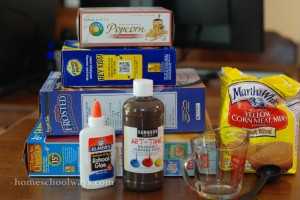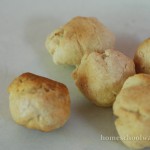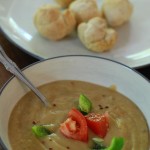Chapter 7 deals with “Hammurabi and the Babylonians,” with a section about Hammurabi’s code. We built a ziggurat by following the instructions in Ancient Egyptians and Their Neighbors. This book is recommended in several SOTW chapters and contains simple projects for kids to do. I am not sure that a first grader could do any of these projects without adult help, but that’s what teaching is all about, right? Leading and guiding a student through his work and hoping that some things will stick.
The book mentioned using corn meal to achieve the texture of a ziggurat and Tempera paint. I gathered all my materials, including the recommended measuring spoon and cup. They said to draw stairs with a black marker. This seemed easier than the ziggurat project in the SOTW Activity Book, which involved cutting stairs out of a cereal box and gluing them.
As my husband walked by, you know, the principal of our school, he saw the gear and asked, “What you’re making, honey?” When I explained, he said, “Oh, I can spray paint your ziggurat and throw some sand on it. Just glue it for me first. Wouldn’t that be easier?”
I’m always for the path of least resistance. So the kids glued the boxes together and, when the spray paint dried, they drew stairs and doors on it with a permanent marker. Now we have a ziggurat to behold and call our own. And we know that everybody participated in the making of it.
From this same book, we made sebetu rolls. My daughter is four and she loved mixing the ingredients until the dough got too firm for her. We enjoyed them with cream of vegetable soup. Very chewy! They got hard the next day, but I microwaved them for 30 seconds and they got all soft and warm. Perfect comfort food for fall days!
- Sebetu Rolls
- Cream of vegetable soup and sebetu rolls
My son read Abu Ali: Three Tales from the Middle East out loud not just for history. It also counted toward his Pizza Hut Book It! reading goals. This book exposes children to Middle Eastern humor, names, and life. Friends call each other “donkey” and fool each other. Food pushes people to do things we might consider unusual.
I grew up with similar stories, so I get it. But my American children, who are used to American story telling, did not shout, “Again!” at the end of the book. However, the next day, my son asked to read it again. He got the humor. From then on, he read it every night until we had to return it to the library.
It really is funny if you understand their sense of humor. Amazon has this title marked as one of the 100 children’s books to read in a lifetime, so definitely include this in your reading inventory.
The Winged Cat seemed too dark. By now, I have learned to preview these books… So I did not even show it to my children and returned it to the library quietly.
We worked through the crossword puzzle and map activity. They did not feel like coloring the ziggurat and I let it go.



